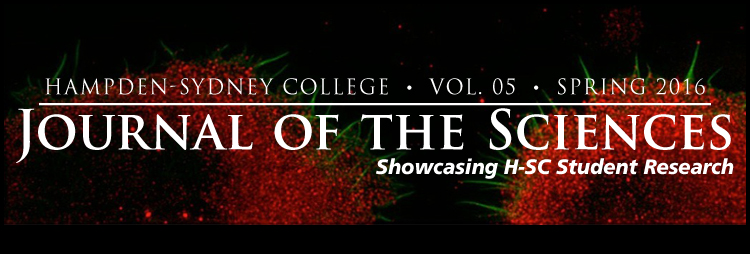EDITORS-IN-CHIEF
Travis B. Goodloe ’16
Shaquann S. Seadrow ’16
EDITORS
Dane R.C. Asuigui ’16
P. Tazewell DelDonna ’17
Brian N. Hulsizer ’16
Reuben P. Retnam ’17
Joshua D. Taylor ’16
ADVISORS
Michael J. Wolyniak
Department of Biology
Hugh O. Thurman III
Department of Physics and Astronomy
Cover Photo: Using antibodies attached to fluorescent molecules along with advances in microscope technology, scientists can track the precise positions of structures within the cell in exquisite detail. Here, mammalian T cells have been treated with drugs designed to inhibit actin cables being visualized with red and green fluorescent molecules that label specific regions of the cell. By taking multiple images of these labeled cells and running them together into a movie, the precise motion of the actin cytoskeleton in response to immunological challenge to the T cells is revealed. This image was taken in the laboratory of Dr. John Hammer at the National Heart, Lung, and Blood Institute of the National Institutes of Health, Bethesda, Maryland (From J. Taylor Meinhardt ’16 under the supervision of Dr. Sricharan Murugesan).
TABLE OF CONTENTS
News from the Hampden-Sydney Science Departments
HAMPDEN-SYDNEY RESEARCH SPOTLIGHTS
Dr. Patrick J. Martin ’02: Providing New Engineering Research Opportunities at Hampden-Sydney
Shaquann S. Seadrow ’16
Student Research Spotlight: A Summer at the NIH
J. Taylor Meinhardt ’16
FEATURE SECTION: PERFORMANCE ENHANCING SUBSTANCES
Performance Enhancing Drugs: Usage & Consequences
Jacob M. Farrar ’16
Human Growth Hormone: A Performance Enhancing Drug
Andrew M. Gorham ’16
ADHD Diagnosis & Psychostimulant Use in the United States
Mel F. Savarese ’16
RESEARCH ARTICLES
ESR Characterization of Induced Reaction Oxygen Species: The Antibiotic Mechanism of Actin Controversy
Myshake S. Abdi ’16 and Herbert J. Sipe
Perfecting a Synthesis Pathway for the Production of a Family of Schiff Base Ligands for Complexing into NN’OS Coordination Spheres
Brant D. Boucher ’17, Conrad W. Brown ’17, Joshua V. Chamberlin ’17, Dane R. Asuigui ’16, and Nicholas P. Deifel
Electromagnetically Coupled Oscillators
J. Taylor Daspit ’16 and Hugh O. Thurman III
Mutational Analysis of TEP1, a Budding Yeast Homologue of the Human Prostate Cancer Factor PTEN
William R. Echols ’17, Zachary S. Martin ’17, and Michael J. Wolyniak
A Study of Phenoxyl Radicals from Bisphenol-A by Fast-Flow ESR Spectroscopy
Andres H. Garcia ’18 and Herbert J. Sipe
The Analysis of Fungal Pathogens Pseudoperonospora humble and Podosphaera macular as they affect the Hops Species Humulus lupus and Humulus japonicas
Christopher M. Hawk ’16, Edward Lowry, and Michael J. Wolyniak
Synthesis of Various Catalysts for the Morita-Baylis-Hillman Reaction
Benjamin W. Lam ’17, A. Mitchel Owens ’16, John W. Sheffield ’16, and Paul H. Mueller
Syntheses and Analyses of Novel Schiff Base Ligands with NN’OS Coordination Spheres
James H. Lau ’17 and Nicholas P. Deifel
Keeping Up with the Investigation on Invasives
Mason E. Luck ’16 and Edward Lowry
Temperature Performance of the Energy Research Laboratory
Reuben P. Retnam ’17 and Paul F. Hemler
Microwave Optics: Analysis of a Cubic Lattice with Bragg Scattering
Zachary G. Shermer ’18 and Hugh O. Thurman III
Effects of Early Handling on Rat Performance in a Radial Arm Maze Task
Quentin M. Smith ’15 and Robert T. Herdegen III
Calibration and Use of a Michelson-Morley Interferometer
Cecil M. Tiblin ’18 and Hugh O. Thurman III
Manipulation of Self-Efficacy in Participants with Incremental or Entity-Implicit Theories of Knowledge
Ryquan D. Wheeler ’15 and Robert T. Herdegen III
